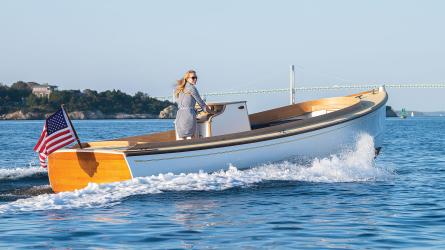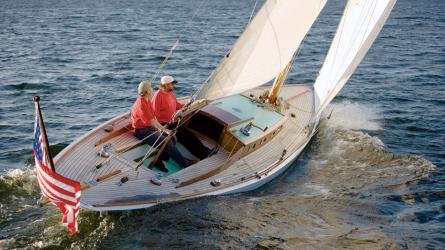PIRATE
A new chapter for a storied Ted Geary–designed R-boat
A new chapter for a storied Ted Geary–designed R-boat

NEIL RABINOWITZ
After being fully restored to sailing condition by professionals with the help of a group of volunteers, PIRATE sails out of The Center for Wooden Boats in Seattle, Washington, not far from where she was originally launched.
In the spring of 1925, yachtsman Don Lee of Los Angeles made a challenge to his son Tommy, a Star-boat sailor of some skill: if he could win the Pacific Coast Star Championship, a new R-boat would be his reward. Whether inspired by this offer or a basic competitive instinct, the young Lee sailed his Star SATELLITE to victory, winning the title at the Pacific Coast Yachting Association (PCYA) Regatta in Victoria, British Columbia.
At the same regatta, the Lees witnessed the clear superiority of the R-boat SIR TOM, which came from Seattle, Washington, and won both the Sir Thomas Lipton Cup and the Isherwood Cup. Don Lee was so impressed by the skill of her skipper and designer, L.E. “Ted” Geary, that he not only ordered a custom R-boat design from Geary to fulfill his promise to Tommy, but also persuaded the designer to serve as skipper for the 1926 Honolulu Race in his own 160' LOA, steel-hulled schooner INVADER (built in 1905 and recently restored in Viareggio, Italy) which he had bought the year before.
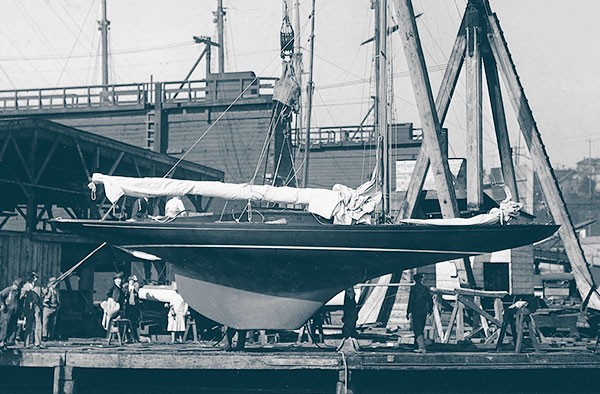
Suspended from her lifting rings at Lake Union Dry Dock on launching day, April 10, 1926, PIRATE shows her racing form.
By August, Geary had the R-boat design underway and, in the fall of 1925, the craftsmen at Seattle’s Lake Union Dry Dock Company began construction of PIRATE. From the beginning, she was intended to be the best-built R-boat on the West Coast. Two huge Douglas-fir timbers were shaped into a keel and horn timber, forming a centerline structure that would keep her fine shape fair and strong for a very long time. Geary specified double planking, the first layer of Western red cedar and the outside layer of Burma teak. This combination made a very rigid hull, but one that is also light and, because of the woods chosen, rot-resistant.
On the construction plans, Geary specified that there were to be no scarf joints in the stringers, clamps, or shelves through the ’midship portion of the boat. The builders went one better: all of these long and structurally important pieces were of full-length Douglas-fir, with no scarf joints of any kind anywhere.
The client had requested teak deck planking, and to keep it light and strong the builders first laid a double-diagonal subdeck of Western red cedar, then applied the teak on top with sporty white caulking in the seams. The housetop was double-diagonal planked red cedar, covered in canvas and painted Chesapeake green.
Launched

At first, PIRATE had a single set of spreaders. A forestay jumper strut was added soon after launching, and in the 1930s Ted Geary redesigned the rig, lowering the spreaders, keeping the jumper strut, and adding diamond struts.
On the sunny afternoon of April 10, 1926, PIRATE was christened and launched on Lake Union in Seattle. A sizable crowd of boatbuilders, yachtsmen, a photographer from the firm of Webster-Stevens, and the curious showed up to witness the event. PIRATE’s sponsor, Miss Virginia Merrill, broke a bottle of Prohibition-era champagne over her bow, and the boat slipped into the lake for her first sail. The launching was duly reported in the next day’s Seattle Post-Intelligencer.
Although PIRATE’s first sail took place in Lake Union’s typically drifting conditions, during the following week Geary assembled two crews to sail PIRATE and SIR TOM against each other—on Puget Sound this time—to prepare the new boat for competition. In varied conditions, they sailed side-by-side in an effort to refine the new boat and to allow the designer to learn more about his latest creation (and future competitor). Before shipping PIRATE south, the yard rigged a large jumper strut on the headstay at the top of the foretriangle. This was done apparently to control mast bend in the upper third of the rig. None of the early PIRATE photos taken in the Northwest show this detail.
Geary and other racing sailors had been transporting sailboats to regattas up and down the West Coast aboard the fast steamer EMMA ALEXANDER, whose regularly scheduled sailings provided a vital link between Seattle and Los Angeles for many years. As he had done with SIR TOM earlier, Geary had PIRATE loaded aboard the ship fully rigged, with the mainsail bent on the boom and its sail cover in place. If the ALEXANDER sank, the joke went, the castaways, if they were quick enough, could sail to safety aboard the R-boat.
Once the boat was in California waters, Geary joined the crew for a few days of rig tuning and tweaking to accommodate the big Wilson & Silsby mainsail. At this point, PIRATE had still not acquired her R-11 racing number.

Lake Union’s working waterfront was bustling when PIRATE was launched in 1926. Although much of the industry is gone, Lake Union Dry Dock is still going strong.
In California
In her first year of competition, PIRATE showed good speed. She won two of the four races at the Southern California Yachting Association Regatta at Newport Harbor in August. Arriving too late to make the first race and placing poorly in the second, PIRATE’s wire-to-wire win on the third day earned her the San Diego Lipton Cup and the attention of the fleet. On the fourth and final day of the Newport Beach regatta, yacht designer Nick Potter sailed PIRATE to her second win while Tommy Lee was racing his Star. The next year, Potter himself designed the R-boat FRIENDSHIP.
In March 1927, the first Mid-Winter Regatta was held in Southern California. Don Lee’s effort and generosity helped to get it off the ground, and he donated a “$500 gold cup” for the winner in the R class. An impressive fleet of R-boats met to race for the trophy off of Los Angeles Harbor, three of which were new boats. Two were just launched, one being Al Christie’s brand-new HEATHER, an Edson Schock design built by Chalker & Whiting, and the other Owen Churchill’s GALLIANO IV, a Geary design fresh out of Lake Union Dry Dock. The third was ACE, a Charles Mower design built by Madden & Lewis in 1926. She was steered by Arthur Rousseau of San Francisco and had gone south just for this regatta. Two other boats raced: PATRICIA, a Charles Nicholson design built by Hoffar in 1921; and DEBRA, a Schock-designed boat built by Herb Matson in 1924.
The series was closely contested, with seconds separating the finishers in each race. Despite the light and fluky conditions, PIRATE never fell out of the top three—winning the first race, finishing third in the second, and just getting nosed out by Ron Maitland’s Canadian PATRICIA to take a second in the final race. When the results were totaled, Tommy Lee won the Don Lee Trophy by the narrow margin of one point. PIRATE scored 15 points, near-sister GALLIANO IV got 14, and PATRICIA ended up third with 12.
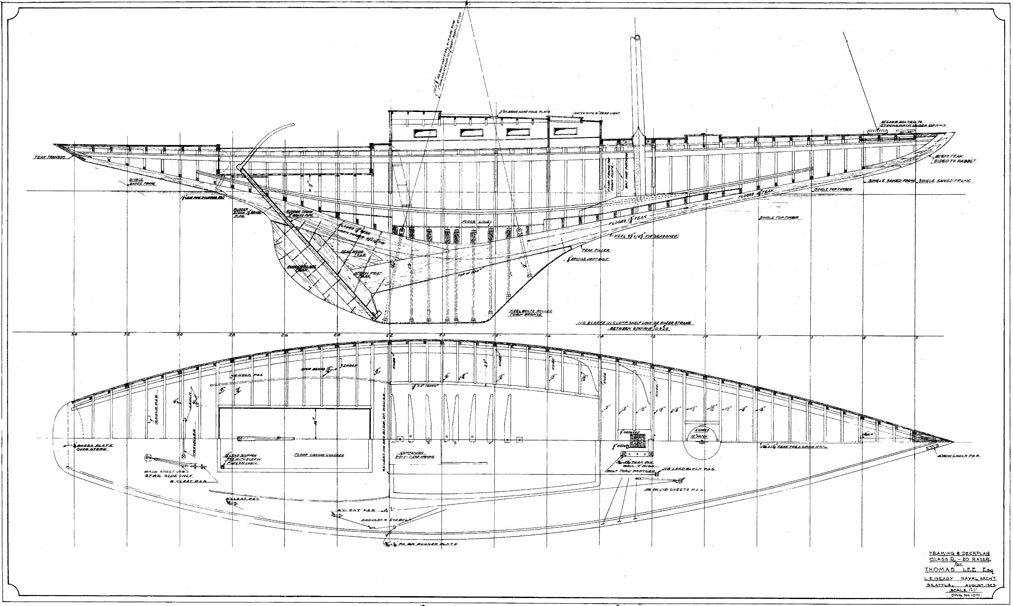
PIRATE’s original construction plan and sail plan—but, unfortunately, not her lines plan—survive. The construction plan provided valuable information about her profile during restoration.
PIRATE, ACE, GALLIANO IV, and HEATHER went north in May of the same year, 1927, to race in the San Francisco Bay Perpetual Challenge Cup. On the bay, they met ACE; RASCAL, a 1922 product of the Stone Boatyard to a design by W.F. Stone; and MACHREE, a design by William Gardner built at Madden Bros. in 1918. PIRATE fared poorly, breaking a boom and a spreader in the first race and failing to start the second. The best she could manage was a third in the fourth race. The lengthy ACE reveled in the fresh breezes, and skipper Arthur Rousseau won the cup for the hometown fleet.
Next, the Isherwood Cup was at stake for the R class during the PCYA Regatta at Santa Barbara. This trophy, emblematic of the West Coast Championship, was held by Ted Geary and SIR TOM of the Seattle Yacht Club. In addition to the defender, the fleet consisted of PIRATE, PATRICIA, FRIENDSHIP, ALOHA (an Edson Schock design built at San Diego Marine Construction in 1924), DEBRA, FRANCESCA (designed by John G. Alden and built by George Kneass in 1922), ZEPHYR (a 1915 Stone Boatyard construction to a W.F. Stone design), ANGELA (another Alden design, built by Wilmington Boat Works in 1922), and CALIFORNIA (a Charles Mower design built by Garbutt & Walsh in 1923).
FRIENDSHIP was the newest boat in the R-boat fleet. She had been completed at Wilmington Boat Works only days before for Owen Churchill to replace GALLIANO IV, which was destroyed when she dragged anchor and drifted onto the beach at Portuguese Bend just west of Point Fermin. FRIENDSHIP was designed by Nick Potter, and her keel was cast from ballast salvaged from the wreck of GALLIANO IV. (An account of the PCYA regatta in the September 1927 Pacific Coast Yachting features a cartoon of skipper Churchill, designer Potter, and Tom Smith, partner in Wilmington Boat Works, watering GALLIANO IV’s keel to get it to “grow” into FRIENDSHIP.)

Rhoda Adamson bought PIRATE in early 1934 and named designer Geary sailing master. Geary, who had a close family friendship with the Adamsons, redesigned the rig to get the boat in racing trim, then shared helm duty with Rhoda during races such as this 1934 Mid-Winter Regatta in Los Angeles.
A Tight Race
On August 9, in a light first race, SIR TOM took the lead after the start and held onto it well into the last upwind leg. Well ahead, Geary sailed into a light patch near shore. Tommy Lee stayed farther offshore and found a fresher breeze. By the time the two boats rounded the weather mark, PIRATE was a few seconds ahead. With the time limit near expiring, Lee held onto the lead for the short run to the finish to beat Geary by 51 seconds and the deadline by less than a minute.
In the next two races, Geary showed the stuff of legends, and SIR TOM won them both convincingly. Following this successful defense, the “Tommy” was taken back to Los Angeles, loaded onto EMMA ALEXANDER, and shipped home to Seattle. (The regatta inspired another cartoon. This one refers to the fact that SIR TOM was the oldest, smallest competitor in the R class. Just as sailors of today refer to the fastest boat in a fleet as the “scratch” boat, yachtsmen of yore called the smallest, slowest vessel the “pickle,” and the cartoon has Geary saying, “How do you California eggs like my pickle boat?” Given Geary’s gregarious nature, it is possible that he might have said something like this during the regatta.)
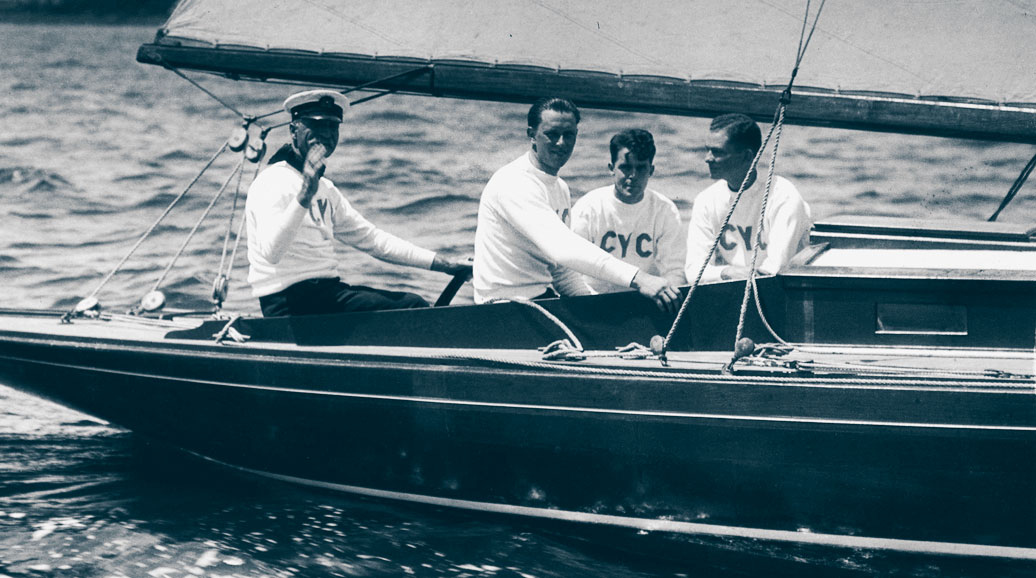
Matt Walsh was at the helm during PIRATE’s finest hour, winning the R-boat national championship at Larchmont, New York, in 1929. His crew, left to right, were Los Angeles Times sportswriter Fox Case and local sailors Gordon Sykes and Manning Staires.
New Owners
One of the best R-boat fleets ever assembled showed up at Los Angeles for the 1928 Mid-Winter Regatta. Among the eight boats entered were the great L. Francis Herreshoff–designed LIVE YANKEE, built by Britt Bros. in 1927 and hailing from Marblehead, Massachusetts; and Ron Maitland’s LADY PAT from Vancouver, British Columbia. LADY PAT was a John G. Alden design built at Vancouver Drydock and Salvage Co. in 1927 to replace Maitland’s PATRICIA of 1921, and Alden himself skippered LADY PAT in the last race of the week. Tommy Lee steered PIRATE to fourth place for the eight-race series with finishes of fifth, fourth, fourth, second, fifth, fourth, fourth, and third. Undoubtedly disappointed at not winning a single race, Lee put PIRATE up for sale right after the regatta.
At the urging of boatbuilder and R-boat skipper Matt Walsh, Roger Marchetti of the California Yacht Club bought PIRATE, and Walsh became her skipper. In their first race, Walsh and Marchetti decisively won the July 22 Los Angeles Times Perpetual Challenge Cup, beating the rest of the fleet by over two miles. After a summer of racing in Los Angeles, they shipped PIRATE north aboard the freighter TEXAN to again challenge ACE for the San Francisco Perpetual. This time, the contest was to be a single match race between these two boats.
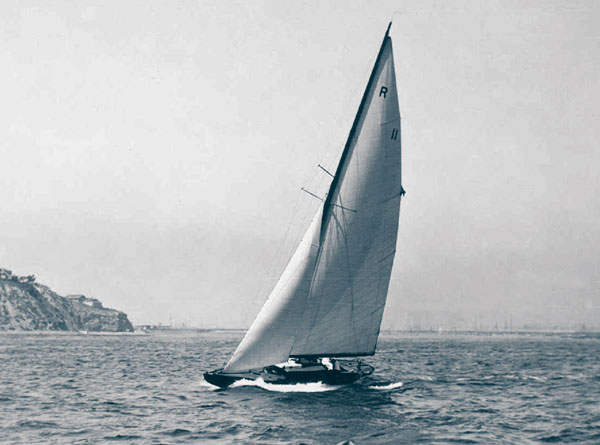
Original owner Tommy Lee kept PIRATE for only two years. He raced her regularly, winning the San Diego Lipton Cup and the Don Lee Trophy in the first Mid-Winter Regatta in 1927. This photo shows her in racing trim with her original rig during the August 1927 Los Angeles Times Perpetual Challenge Cup.
Although Walsh sailed PIRATE on San Francisco Bay for a week leading up to race day, PIRATE suffered a breakdown during the race. Trailing by a minute and three-quarters early in the race, her finish was made worse by the loss of a deck block for the main halyard that allowed the sail to drop several feet on the last leg. More at home in the bay chop, the robust ACE finished four minutes ahead of PIRATE to easily retain the trophy.
Great Things in the Land of Herreshoff and Alden
PIRATE’s golden moment in yachting history came in 1929. In the off-season, Marchetti had informed Walsh of his desire to sell the boat. Walsh had a pretty good idea that she had more speed than her 1928 season results might indicate, so he approached another California Yacht Club member, Commodore O.C. Hunsaker, and suggested that he buy the boat. The deal was made, and Walsh started preparing PIRATE for the most important campaign of her life.
Commodore Hunsaker was not the commodore of the California Yacht Club but of the Southern California Outboard Association. A keen competitor and an eager boating booster, Hunsaker was enthusiastic when the possibility of campaigning PIRATE on the East Coast came up. Charles Welch of Boston had brought LIVE YANKEE west to race in the Mid-Winter Regatta, and a return gesture seemed in order.

PIRATE, with her rig fully set up and sails bent on, was secured in a cradle on deck aboard EMMA ALEXANDER for shipment from her builders in Seattle to her owners in California.
PIRATE was once again loaded onto the deck of a freighter, this time bound, via Panama, for Long Island Sound. “The entry of PIRATE in eastern races,” Yachting magazine reported, “marks the first time that a Western-designed and built yacht, sailed by western yachtsmen, has raced on the Atlantic Coast.”
Walsh took sportswriter Fox Case with him as crew. Once at Larchmont, New York, they picked up local sailors Gordon Sykes and Manning Staires as crew. After two races, the scores for the top positions were very close. On July 23, the day of the third race, Walsh made his move. He took the start at the committee boat and led the fleet all the way to the weather mark off Scotch Caps. In clear air with the wind from the northeast, he rode a starboard tack lift, tacking only three times. PIRATE held her lead on the run across the sound to Hempstead Harbor and on the final close reach to the finish line at the Larchmont breakwater. Behind her was the entire R-boat fleet and a few of the larger, faster Q-boats as well.
The competition remained tight to the end of the regatta, but PIRATE was clearly up to the competition. At the end of the series, she finished on top with 35 points, a single point ahead of L. Francis Herreshoff’s YANKEE, a 1925 Britt Bros. construction. DORESS, an Alden design built by Lawley in 1925, finished the week even on points with YANKEE but lost the tiebreaker.
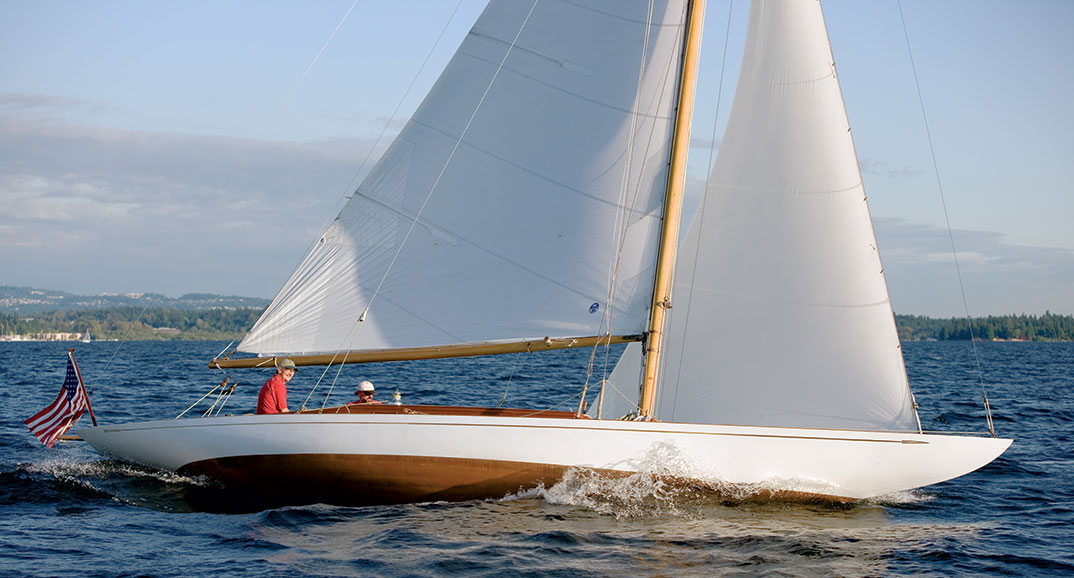
NEIL RABINOWITZ
With the long overhangs typical of the Universal Rule, PIRATE today sails Seattle’s lakes and Puget Sound to provide a touchstone for the city’s yachting history.

Matt Walsh wasn’t afraid to make out-of-the-ordinary choices, and when it came time for a new suit of sails while he raced the boat for Commodore O.C. Hunsaker, Walsh specified a green jib and a black mainsail with a cartoon pirate.
The Henry Gielow–designed BOB KAT, which became the 1927 Long Island Sound champion one year after her construction at Lawley’s, was fourth with 33 points. Two points behind her in fifth place was PUFFIN, a Nathanael Herreshoff design launched at the Herreshoff Mfg. Co. in 1927. At the end, PIRATE, flying the burgee of the California Yacht Club, was named the R-boat National Champion.
PIRATE was loaded up and well on her way back to Los Angeles when the stock market crashed.
The 1930s
PIRATE continued to race locally in Southern California. Hunsaker gave Walsh a free hand, and the old veteran ordered a special suit of sails: a black mainsail and spinnaker set off by a green jib. Not only were the colors unconventional, but also the mainsail had a cartoon pirate character in the middle—complete with sword, hat, and sash. Walsh liked to decorate sails this way. The mainsail on his own yacht, THOROBRED, featured the silhouette of a horse’s head.
In 1930, the Don Lee Trophy races attracted two entries from the East Coast. One, from Indian Harbor, Connecticut, was Charles Deere Wiman’s ALERT IV, a Nevins-built Mower design from 1928. The other was a Larchmont-based boat, Clare Farrand’s ROBIN, designed by Starling Burgess and built at Abeking & Rasmussen in 1928. Aboard PIRATE, Walton Hubbard took the helm for the first race, finishing second. Matt Walsh skippered her for the rest of the series.
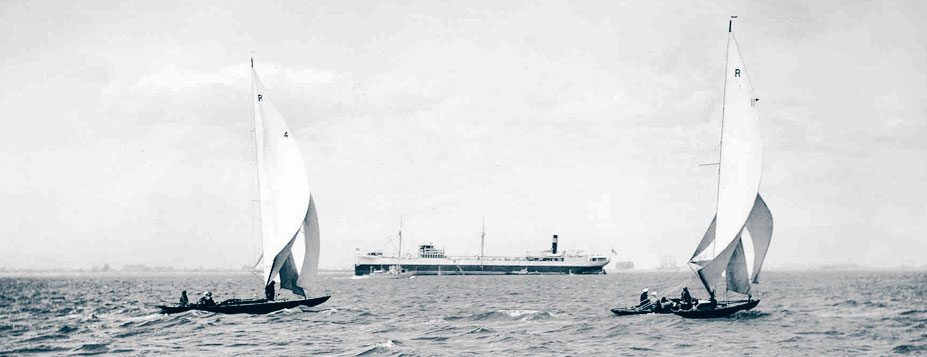
PIRATE (right) and ALERT IV were both competitive racers in the late 1920s. In the 1930 Mid-Winter Regatta, a year after this photo was taken on March 13, 1929, the two boats collided. PIRATE’s bright-finished hull was gouged, and thereafter she was painted white.
In very close racing, ROBIN won the cup despite skipping the first race and having an exciting last race in which the series lead changed hands several times. An awful collision occurred in that final race, costing ALERT the series (she finished second) and sending PIRATE into a navigation buoy. Her varnished teak hull was deeply gouged on the port side, and not long after, she was painted white.
In the next year’s Don Lee Cup, ALERT and PIRATE both lost masts in separate races—yet finished first and second, respectively, for the series.
PIRATE was sold at the beginning of the 1932 season to Arthur Stewart, son of W.L. Stewart, late president of Union Oil Co. of California. With R-boat racing waning during the Great Depression and with the newly formed North American Yacht Racing Union’s adoption of the International Rule, Stewart decided to convert PIRATE to a fast auxiliary cruiser. He had Garbutt & Walsh install a 44-hp Graymarine engine, a marine head, and some interior cabinetry. As a “cruiser,” PIRATE still raced successfully as a handicap sloop and won the 1932 Nordlinger Trophy under Stewart’s command.
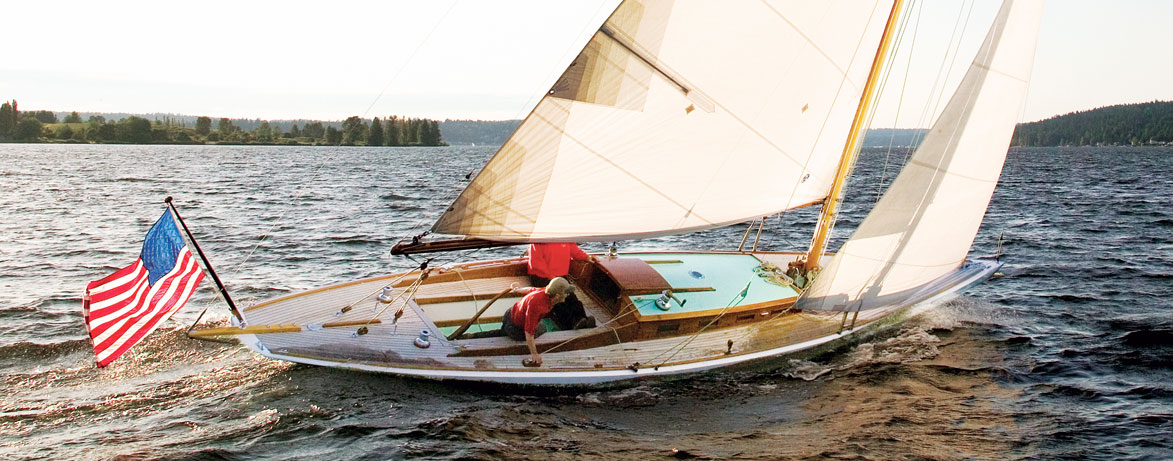
NEIL RABINOWITZ
During restoration, PIRATE was given her post-1934 configuration, including the boomkin and permanent backstay. Her deck arrangement is the same as the original, and—true to the original—she carries no auxiliary power.
PIRATE Reborn
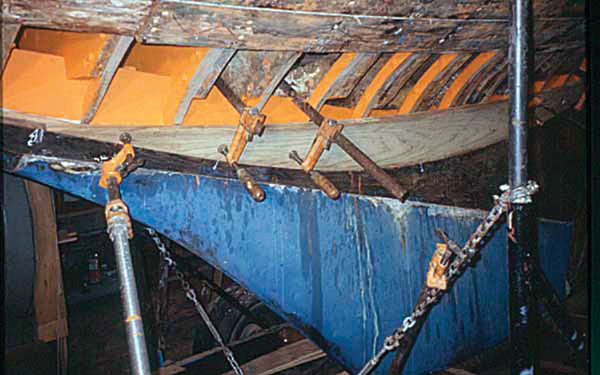
During restoration, PIRATE received new frames, floor timbers, and garboards. During restoration, PIRATE received new frames, floor timbers, and garboards.
Ted Geary finished his term as commodore of the Seattle Yacht Club in 1931 and shortly thereafter relocated his office from Seattle to Los Angeles. A number of large motoryacht projects were underway in Southern California, and several yachts built to his designs were already there. The promise of more business in the new location was a real one. The “movies” had become “talkies,” and members of the seemingly Depression-proof film and petroleum industries had fallen in love with yachting.
While still in Seattle, Geary had designed a 100′ fantail motoryacht for May K. Rindge and her daughter, Rhoda Adamson. Built at Blanchard Boat Yard on Lake Union, the yacht was christened MALIBU after the stretch of shoreline west of Los Angeles that the Adamsons called home. When Geary moved to Southern California, his friendship with the Adamsons grew. Rhoda Adamson was a keen sailor and enthusiastic yachtswoman, and when she bought PIRATE in early 1934 she named Geary sailing master and co-helmsman.
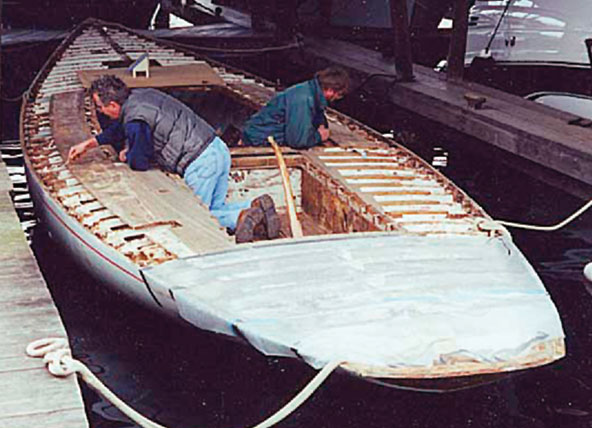
A plywood overlay, though it may have helped preserve the boat from worse deterioration, had to be removed to make way for a new teak deck replicating the original.
To prepare the boat for more serious racing, Geary had the engine and propeller shaft removed. He redesigned the sail plan and rigging, giving the rig a more modern configuration that would allow the use of a genoa jib sheeted closer to the mainsail. To do this, the spreaders were moved to a point halfway between the forestay and the deck. The top attachment point of the upper shrouds was moved down to the forestay connection. Two diamond struts, the same length as the spreaders, were added at the same place. To control masthead bend fore-and-aft, a jumper strut was fitted from the forestay tang to the headstay, and a smaller strut was rigged on a jumper above the forestay. The forestay was moved 4′ farther up the mast, while the foretriangle base was kept at 10′. This increased foretriangle area was offset by a reduction in mainsail area, with a 14″ shorter foot and the gooseneck raised 18″. At this time, a 15″ boomkin was added at the stern to attach a standing backstay, which PIRATE had never had before, bringing her sparred length to 40′3″. To handle the genoa sheets, a pair of winches was fitted on the aft end of the cabintop, one to port and one to starboard.
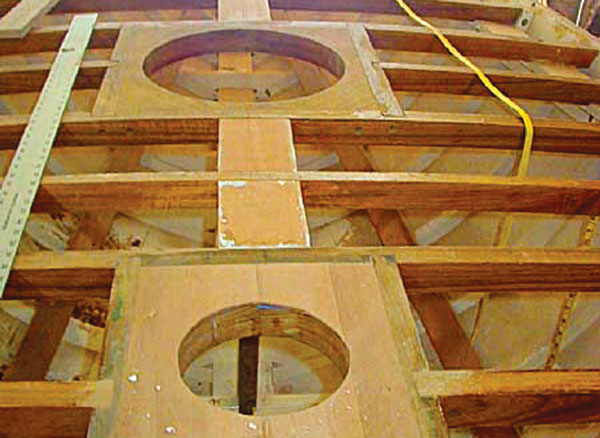
Deckbeams, centerline blocking, and the mast partners were all replaced during the construction of the new deck.
A Faster PIRATE
With her new sail plan, PIRATE was immediately faster. In one of her first regattas in this configuration, she won the 1934 Nordlinger Trophy race at Long Beach. Geary was at the helm both days, and in the Sunday race PIRATE caught and passed three Eight-Meter-class boats that started ahead of her.
If her 1929 East Coast showing was PIRATE’s golden moment, then 1935 was her swan song. R-boat interest was waning, and those boats still racing did so in mixed fleets, sharing the starting line with the emerging Six-Meter class, which had gained added popularity as one of the sailing classes at the 1932 Los Angeles Olympic Games.
The first racing that year was for the San Diego Lipton Cup on January 2 off Los Angeles Harbor. The Lipton Cup had not been back to San Diego since 1931, and FRIENDSHIP, skippered by Ashley Bown of San Diego Yacht Club, was the only challenger from the border town. In the single 12-mile race, PIRATE beat FRIENDSHIP by 29 seconds. Seven Six-Meters followed.
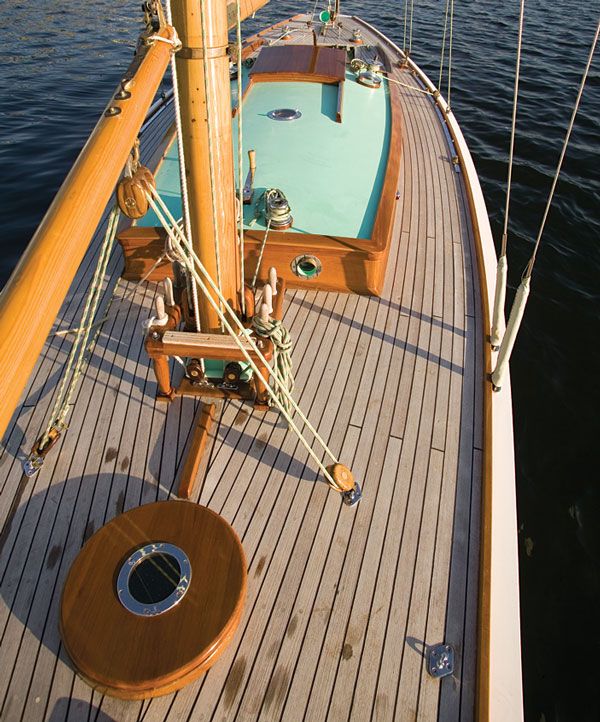
NEIL RABINOWITZ
PIRATE’s structural integrity was restored by boatbuilder Brad Rice, and Dan Turner rebuilt the trunk cabin. A cadre of volunteers from The Center for Wooden Boats helped.
In July, PIRATE won the Los Angeles Times Trophy and, the following day, repeated as Nordlinger Trophy winner. Geary and Rhoda Adamson shared the helm and completed a very successful season by winning all three races at the Pacific Coast Championship Regatta (PCYA–SCYA) at San Diego. As a result of the season’s results, the SCYA named Ted Geary “Southern California Skipper of the Year” for 1935.
Through the Great Depression and World War II, PIRATE remained in the Adamson’s ownership, and she was lovingly maintained. In 1952, young Merritt Adamson, Jr. married Sharon Geary, daughter of PIRATE’s designer. For a wedding present, the elder Adamsons gave the R-boat to the newlyweds. At the same time, the father of the bride drew up pen-on-linen renderings of PIRATE’s sail and construction plans, had them framed, and gave them to the young couple.
The younger Adamsons kept PIRATE for the next 12 years. While they rarely raced her, they used the boat regularly for daysailing and short cruises to Catalina Island. Sharon, whose last name is now Gee, remembers the boat as being strong, sound, and a capable cruiser. True to the original design and purpose, she had no engine, pulpits, or lifelines during their ownership. Their one concession to comfort was a marine toilet mounted in a cabinet just to starboard of the companionway ladder—which Sharon remembers as not entirely satisfactory or especially private.
During the Adamson family’s ownership, PIRATE was regularly and professionally maintained. This, more than any other single factor, is probably why PIRATE still exists today and why she was a prime candidate for restoration.

NEIL RABINOWITZ
PIRATE’s deck and rigging fittings are original.
The 1960s and Beyond
After more than 30 years of ownership, the Adamson family sold PIRATE to Brooks Barnhill and Morton Caplan of Los Angeles. They cruised and raced the boat fairly actively. In races using the Performance Handicap Racing Formula (PHRF), she continued her winning ways and picked up a few cups for both skippers. The new owners loved her immediately, and although they added lifelines and occasionally an outboard motor to comply with safety regulations, they resisted adding an inboard engine.
PIRATE’s history from the 1970s on is one of club racing and maintenance work, primarily by brothers Kerry and Dennis Sullivan of Oxnard, California. At the time Kerry Sullivan bought the boat, the wooden mast and boom had been replaced with aluminum spars. Before that, she had acquired another inboard engine. When the deck began to leak badly, it was sheathed with plywood and painted. Although Dennis Sullivan has expressed frustration at not redecking her to match the original construction, the plywood deck went a long way to preseve the boat for her ultimate restoration.

NEIL RABINOWITZ
Author Scott Rohrer, right, and Paul Marlow were among PIRATE’s restoration volunteers. A syndicate was formed to purchase and restore the yacht, after which the organization donated her to The Center for Wooden Boats, where she offers rides to the general public. The volunteers continue the perpetual task of her upkeep.
In the late 1990s, PIRATE’s then-owner, Adele Jacobson of Oxnard, California, sold PIRATE to the Blue Whale Sailing School in Santa Barbara. Founded by John Ascuncion, Blue Whale developed sailing programs for children of South Seas islander families to give them opportunities to develop boating skills and interests. Blue Whale moved its operations to Lake Tahoe in 1999 but chose not to take PIRATE along. Ascuncion contacted The Center for Wooden Boats (CWB) in Seattle, hoping that the boat could return to the place of her origins and find a happy home there. The vagaries of the tax laws prevented a direct donation to the CWB, which lacked the funding to purchase PIRATE at anywhere near the asking price.
Ultimately, a group of Seattle yachtsmen formed the Pirate Syndicate to purchase the boat. Ascuncion and his wife generously contributed enough to the transaction to make it affordable for the buyers and acceptable to the Internal Revenue Service.
In late July 1999, I went to Ventura, California, to pack up the boat and make her ready for the trip north. A truck from Dudley Boat Transport showed up, the crew at Channel Islands Boatyard loaded PIRATE, and she started the trip home.
Home Again
Through the summer and fall of 1999, The Center for Wooden Boats kept PIRATE at its docks at south Lake Union, just a half mile from Lake Union Dry Dock, where she was launched almost 75 years earlier. In October of that year, the Pirate Syndicate officially donated this graceful racer to the CWB in a ceremony at the Boathouse.
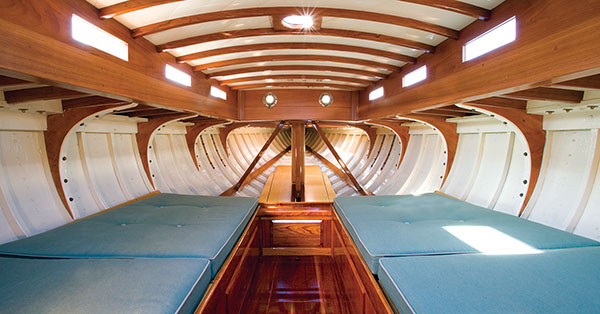
NEIL RABINOWITZ
Below deck, PIRATE is all racing machine, as she was built to be.
Since then, this boat has become the center for a new focus at CWB on northwest yachting and boatbuilding. In all, a little more than $90,000 was raised to fund a six-year-long restoration using techniques and materials as close to original as possible. Boatbuilder Brad Rice took on the reframing and replanking work, and his colleague Dan Turner tackled the reconstruction of the trunk cabin and coamings. They were ably assisted by a dedicated corps of volunteers from the CWB.
PIRATE sailed again in 2005, after an April rechristening. Today, she sails regularly out of the CWB, serving to interpret early pleasureboat building on Lake Union for the public—including taking them for sails almost any Sunday afternoon between April and October. 

The tradition of PIRATE pond yacht racing continues today at The Center for Wooden Boats. Lena Cardozo won this final heat to win the 2004 Pirate Cup.
In 1927, PIRATE became the object of an unusually ambitious program to get West Coast youngsters involved in sailboat racing in general and R-boats in particular. At the urging of Fox Case, a sportswriter for the Los Angeles Evening Herald, Hearst Newspapers commissioned Ted Geary to adapt PIRATE’s design to a 1⁄12-scale model of the boat for building and racing by schoolboys. During the first year, regattas for the model yachts were held at West Lake (now MacArthur Park) in Los Angeles and at Green Lake in Seattle.
At the first Los Angeles regatta, the winner was one John K. Bussey. Not only did he win a lovely silver cup, but he also was taken racing aboard PIRATE as a guest of Tommy Lee. The Seattle regatta the same year was sponsored by the Seattle Post-Intelligencer and run by none other than Ted Geary and the great Swift Baker, Geary’s sail trimmer from SIR TOM. The winner was “J. Carlson,” who received a fine cup donated by the Frederick & Nelson department store. —SR
In addition to extensive sail racing, Scott Rohrer, a fourth-generation Seattle native, has worked as a rigger, boatbuilder, sailmaker, and professional skipper. He now works in the marine insurance business. He is involved in numerous ways in local maritime historical projects for The Center for Wooden Boats, the Seattle Yacht Club, and the Puget Sound Maritime Historical Society.
